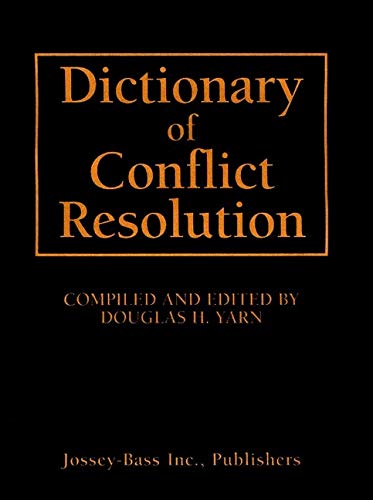Cultural Variation in Conflict Resolution: Alternatives To Violence

Buy online ($)
Type
Book
Authors
FRY ( Douglas P., Kaj Bjorkqvist )
ISBN 10
0805822224
ISBN 13
9780805822229
Category
303.69-Social Processes
[ Browse Items ]
Publication Year
1996
Publisher
Pages
274
Subject
1. Prevention -- Cross-cultural studies; 2. conflict resolution; ISRA; 3. aggression; 4. cultural variation; 5. violence;
Description
This volume's central purpose is to provide a clearly written, scholarly exploration of cultural variation regarding conflict resolution and in so doing, highlight certain alternatives to violence. It presents an interdisciplinary examination of how conflicts are perceived and handled in a variety of cultural settings. Drawing on data and models from anthropology, psychology, and political science, the chapters analyze conflict resolution across the societal spectrum, including cases from Western and non-Western traditions, complex and tribal societies, and violent and non-violent cultures. While demonstrating the extremely important impact of culture on conflict resolution processes, the book does not solely emphasize cultural specificity. Rather--through introductory chapters, section introductions, and a concluding chapter--the volume editors draw attention to cross-cultural patterns in an attempt to further the search for more general conflict principles. An explicit message throughout the book is that alternatives to violence exist. The volume demonstrates that at various levels--from the interpersonal to the international-- conflicts can be handled in ways that cause far less pain and destruction than violence. Chapters by psychologists discuss social and cognitive processes for facilitating the learning of alternatives to violence among children and youth. Anthropology contributors explore mechanisms for dealing with social conflict which allow some cultures to remain relatively peaceful and consider implications of their work for reducing violence in other societies. Chapters by former President of Costa Rica, Oscar Arias, and by political scientists examine how non-violent political solutions can be employed as alternatives to warfare and violent resistence. - from Amzon
Biblio Notes
Table of Contents
Part I Introduction and Theoretical Considerations ......................................p. 1
References .............................................................................p. 2
1 Introduction- Conflict-Resolution Themes ......................................p. 3
References .............................................................................p. 6
2 Culture and Conflict-Resolution Models: Exploring Alternatives to Violence ............................................................................................................p. 9
References .............................................................................p. 21
3 The Inevitability of Conflict but Not of Violence: Theoretical Considerations on Conflict and Aggression ......................................................................p. 25
References ..............................................................................p. 35
Part II Cultural Influences and Conflict Resolution ................................p. 37
References ...............................................................................p. 39
4 Conflict Life Cycles in Occident and Orient ........................................p. 41
References ...............................................................................p. 49
5 A Community of Interests: Semai Conflict Resolution .........................p. 51
References ...............................................................................p. 58
Acknowledgments .......................................................................p. 58
6 Conflict Avoidance and Resolution Among the Toraja of South Sulawesi, Indonesia ..............................................................................................p. 59
References ...............................................................................p. 67
7 Conflict Resolution in Native Margariteño Society ........................p. 69
Acknowledgment .......................................................................p. 76
References ...............................................................................p. 77
8 Leaving Anger Outside the Kava Circle: a Setting for Conflict Resolution in Tonga ..............................................................................................p. 79
Acknowledgment .......................................................................p. 87
References ...............................................................................p. 87
Part III The Challenge of Resolving Ethnic Conflict ................................p. 89
References ...............................................................................p. 90
9 The Eye of the Storm: from War to Peace -- Examples from Sri Lanka and Mozambique ...................................................................................p. 91
References ...........................................................................p. 103
10 Avoidance Strategies in Northern Ireland ....................................p. 105
References ...........................................................................p. 112
Acknowledgment ...................................................................p. 112
11 Historiography and Islamic Vocabulary in War and Peace: a Memento for Conflict Resolution in the Muslim World ..............................................p. 115
Reference .....................................................................................p. 122
12 Conflict Resolution in a Highly Stressful Society: the Case of Israel p. 123
References .............................................................................p. 134
Acknowledgments .....................................................................p. 134
13 Beyond the Competition of Tears: Black-Jewish Conflict Containment in a New York Neighborhood ....................................................................p. 137
Acknowledgments ...................................................................p. 143
References ...........................................................................p. 143
Part IV Conflict Resolution as an Alternative to War ............................p. 145
References ..........................................................................p. 146
14 Esquipulas Ii: the Management of a Regional Crisis ....................p. 147
References ..........................................................................p. 157
15 Cooperation in Conflict: the Latin American Diplomatic Style of Cooperation in the Face of Foreign Threats ..........................................................p. 159
Acknowledgments ..................................................................p. 170
References ..........................................................................p. 170
16 Nonviolent Conflict Resolution and Civic Culture: the Case of Czechoslovakia ...................................................................................p. 173
Acknowledgments ...................................................................p. 181
References ...........................................................................p. 181
Part V Socialization for Conflict Resolution ....................................p. 183
17 Sex Differences in Styles of Conflict Resolution: a Developmental and Cross- Cultural Study with Data from Finland, Israel, Italy, and Poland .....p. 185
References ...........................................................................p. 195
18 A Cognitive-Ecological Approach to the Prevention and Mitigation of Violence and Aggression in Inner-City Youth ............................................p. 199
References ...........................................................................p. 210
Acknowledgment ...................................................................p. 210
19 Tackling Peer Victimization with a School-Based Intervention Program ..........................................................................................................p. 215
Acknowledgments ...................................................................p. 229
References ...........................................................................p. 229
Part VI Conclusions ...................................................................p. 233
References ..........................................................................p. 234
20 On Respecting Others and Preventing Hate: a Conversation with Elie Wiesel .........................................................................................p. 235
21 Conclusions: Alternatives to Violence..........................................p. 243
.
Number of Copies
1
| Library | Accession No | Call No | Copy No | Edition | Location | Availability |
|---|---|---|---|---|---|---|
| Main | 428 |
303.69 FRY |
1 | Yes |




